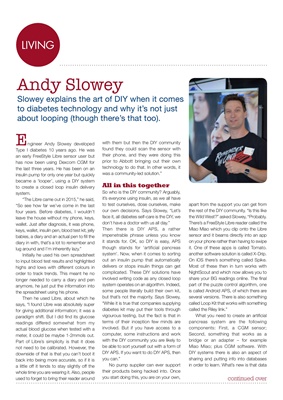
LIVINGLIVING
Andy Slowey
Slowey explains the art of DIY when it comes
to diabetes technology and why it's not just
about looping (though there's that too).
Engineer Andy Slowey developed
Type I diabetes 10 years ago. He was
an early FreeStyle Libre sensor user but
has now been using Dexcom CGM for
the last three years. He has been on an
insulin pump for only one year but quickly
became a 'looper', using a DIY system
to create a closed loop insulin delivery
system.
"The Libre came out in 2015," he said,
"So see how far we've come in the last
four years. Before diabetes, I wouldn't
leave the house without my phone, keys,
wallet. Just after diagnosis, it was phone,
keys, wallet, insulin pen, blood test kit, jelly
babies, a diary and an actual pen to fill the
diary in with, that's a lot to remember and
lug around and I'm inherently lazy."
Initially he used his own spreadsheet
to input blood test results and highlighted
highs and lows with different colours in
order to track trends. This meant he no
longer needed to carry a diary and pen
anymore, he just put the information into
the spreadsheet using his phone.
Then he used Libre, about which he
says, "I found Libre was absolutely super
for giving additional information; it was a
paradigm shift. But I did find its glucose
readings differed somewhat from my
actual blood glucose when tested with a
meter, it could be maybe 1-2mmols out.
Part of Libre's simplicity is that it does
not need to be calibrated. However, the
downside of that is that you can't boot it
back into being more accurate, so if it is
a little off it tends to stay slightly off the
whole time you are wearing it. Also, people
used to forget to bring their reader around
with them but then the DIY community
found they could scan the sensor with
their phone, and they were doing this
prior to Abbott bringing out their own
technology to do that. In other words, it
was a community-led solution."
All in this together
So who is the DIY community? Arguably,
it's everyone using insulin, as we all have
to test ourselves, dose ourselves, make
our own decisions. Says Slowey, "Let's
face it, hall diabetes self-care is the DIY,
we don't have a doctor with us all day."
Then there is DIY APS, a rather
impenetrable phrase unless you know
it stands for. OK, so DIY is easy, APS
though stands for 'artificial pancreas
system'. Now, when it comes to sorting
out an insulin pump that automatically
delivers or stops insulin things can get
complicated. These DIY solutions have
involved writing code as any closed loop
system operates on an algorithm. Indeed,
some people literally build their own kit,
but that's not the majority. Says Slowey,
"While it is true that companies supplying
diabetes kit may put their tools through
vigourous testing, but the fact is that in
terms of their inception few minds are
involved. But if you have access to a
computer, some instructions and work
with the DIY community you are likely to
be able to sort yourself out with a form of
DIY APS. If you want to do DIY APS, then
you can."
No pump supplier can ever support
their products being hacked into. Once
you start doing this, you are on your own,
apart from the support you can get from
the rest of the DIY community. "Is this like
the Wild West?" asked Slowey, "Probably.
There's a FreeStyle Libre reader called the
Miao Miao which you clip onto the Libre
sensor and it beams into directly into an
app on your phone rather than havging
to swipe. One of these apps is called
Tomato. another software solution is
called X-Drip. On iOS there's something
called Spike. Most of these then in turn
works with NightScout and which now
allows you to share your BG readings
online. The final part of the puzzle control
algorithm, one is called Android APS, of
which there are several versions. There is
also something called Loop Kit that works
with something called the Riley link."
What you need to create an artificial
pancreas system are the following
components: First, a CGM sensor;
Second, something that works as a
bridge or an adapter - for example
Miao Miao; plus CGM software. With
DIY systems there is also an aspect of
sharing and putting info into databases
in order to learn. What's new is that data
continued over